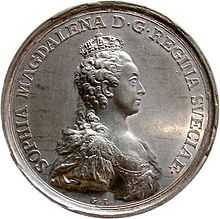Queen consort
A queen consort (also empress consort) is the wife of a reigning king (or emperor). A queen consort usually shares her husband's rank and holds the feminine equivalent of the king's monarchical titles. Historically, queens consort do not share the king regnant's political and military powers. A queen regnant is a queen in her own right with all the powers of a monarch, usually becoming queen by inheriting the throne on the death of the previous monarch; they have been far fewer in number.

Titles
The wife of a reigning king is called a queen consort. The husband of a reigning queen is usually not called "king consort", although it was more common in Europe's past for husbands of queens regnant to become reigning kings (e.g. Philip II of Spain in England, Antoine of Bourbon-Vendôme in Navarre, Ferdinand of Saxe-Coburg-Gotha in Portugal, etc.) or indeed kings consort (Francis of Spain). He is normally called a prince consort.
Where some title other than that of king is held by the sovereign, his wife is referred to by the feminine equivalent, such as princess consort or empress consort.
In monarchies where polygamy has been (such as Morocco and Thailand) or is still practiced (such as the Zulu nation and the various Yoruba polities), the number of wives of the king varies. In Morocco, the present king Mohammed VI has broken with tradition and given his wife, Lalla Salma, the title of princess. Prior to the reign of King Mohammed VI, the Moroccan monarchy had no such title. In Thailand the queen and king must be of royal blood. The king's other consorts are accorded royal titles that confer status. Other cultures maintain different traditions on queenly status. A Zulu chieftain designates one of his wives "Great Wife", which would be the equivalent to queen consort. Conversely, in Yorubaland, all of a chief's princesses consort are essentially of equal rank. Although one of their number, usually the one that has been married to the chief for the longest period of time, may be given a chieftaincy of her own to highlight her relatively higher status when compared to the other wives, she does not share her husband's ritual power as a chieftain. When a woman is to be vested with an authority similar to that of the chief, she is usually a lady courtier in his service who is not married to him but who is expected to lead his female subjects on his behalf.
Role of the queen consort
In general, the consorts of monarchs have no power per se, even when their position is constitutionally or statutorily recognized. However, often the queen consort of a deceased king (the queen dowager or queen mother) has served as regent while her child, the successor to the throne, was still a minor — for example:
- Anne of Kiev, wife of Henry I of France
- Marie de Medici, mother of Louis XIII of France
- Mary of Guise, mother of Mary, Queen of Scots
- Maria Christina of Austria, mother of Alfonso XIII of Spain
- Helen of Greece, mother of King Michael of Romania
- Munjeong, mother of King Myeongjong of Korea
- Emma of Waldeck and Pyrmont, mother of Wilhelmina of the Netherlands
- Lakshmi Bai, the Rani of Jhansi and mother of Damodar Rao
Besides these examples, there have been many cases of queens consort being shrewd or ambitious stateswomen and, usually (but not always) unofficially, being among the king's most trusted advisors. In some cases, the queen consort has been the chief power behind her husband's throne; e.g. Maria Luisa of Parma, wife of Charles IV of Spain, and Alexandra Feodorovna (Alix of Hesse), wife of Nicholas II of Russia.
Examples of royal consorts

Past queens consort: .
- Queen Royal Noble Consort Jang concubine, consort to Sukjong of Joseon.
- Queen Marie Antoinette, consort to Louis XVI of France.
- Queen Mary, consort of George V.
- Queen Alexandra, consort of Edward VII.
- Queen Elizabeth, consort of George VI.
- Queen Fabiola, consort of Baudouin I of the Belgians.
- Empress Carlota, consort of Maximilian I of Mexico.
- Queen Marie José, consort of Umberto II of Italy.
- Queen Kapiolani, consort of King Kalākaua of Hawaiʻi.
- Queen Soraya Tarzi, consort of King Amanullah Khan of Afghanistan.
- Tsaritsa Ioanna, consort of Tsar Boris III of Bulgaria.
- Queen Tadj ol-Molouk Ayromlou, consort of Reza Shah Pahlavi of Persia.
- Empress Farah Pahlavi, consort of Mohammad Reza Shah of Iran.
- Queen Regent Saovabha Bongsri, consort of Chulalongkorn of Siam.
- Panapillai Amma (queen consort) Srimathi Lakshmi Pilla Kochamma Chempakaraman Arumana Ammaveedu, wife of Visakham Thirunal Maharajah of Travancore.
- Queen Catherine, first Queen consort of Henry VIII of England, she was also regent when he was in a war in France.
- Queen Hortense, consort of Louis Bonaparte, King of Holland.
- Queen Wilhelmine, consort of William I of the Netherlands.
- Queen Anna Pavlovna, consort of William II of the Netherlands.
- Queen Sophie, first consort of William III of the Netherlands.
- Queen Emma, second consort of William III of the Netherlands. When William died on 23 November 1890, Emma became regent (1890–1898) for her underaged daughter, Wilhelmina, the late king's only surviving child.
- Queen Ratna, second consort of Mahendra of Nepal.
See List of British consorts for a more complete list of queens consort of the United Kingdom.
Present queens consort:
- Queen Nanasipauʻu Tukuʻaho, consort of Tupou VI of Tonga
- Queen 'Masenate, consort of Letsie III of Lesotho.
- Empress Michiko, consort of Akihito of Japan.
- Sheikha Jawahir bint Hamad Al Thani, consort of Tamim bin Hamad Al Thani of Qatar.
- Queen Jetsun Pema, consort of Jigme Khesar Namgyal Wangchuck of Bhutan.
- Queen Máxima, consort of Willem-Alexander of the Netherlands.
- Queen Mathilde, consort of Philippe of Belgium.
- Queen Rania, consort of Abdullah II of Jordan.
- Queen Silvia, consort of Carl XVI Gustaf of Sweden.
- Queen Sirikit, consort of Rama IX of Thailand.
- Queen Letizia, consort of Felipe VI of Spain.
- Queen Sonja, consort of Harald V of Norway.
- Queen Sylvia, consort of Muwenda Mutebi II of Buganda. Her official title is Nnabagereka of Buganda.
- Queen Pengiran Anak Saleha, consort of Hassanal Bolkiah of Brunei.
Because queens consort lack an ordinal with which to distinguish between them, many historical texts and encyclopedias refer to deceased consorts by their pre-marital or maiden name or title, not by their marital royal title.
Thus:
- Queen Mary, consort of George V, is usually called Mary of Teck.
- Queen Maria José, consort of Umberto II of Italy, is usually called Marie José of Belgium.
- Queen Philippa, consort of John I of Portugal, is usually called Philippa of Lancaster.
- Queen Elizabeth, consort of Henry VII is called Elizabeth of York.
- Queen Catherine, first consort of Henry VIII, is called Catherine of Aragon.
- Queen Anne, second consort of Henry VIII, is called Anne Boleyn.
- Queen Jane, third consort of Henry VIII, is called Jane Seymour.
- Queen Anne, fourth consort of Henry VIII is called Anne of Cleves.
- Queen Catherine, fifth consort of Henry VIII is called Catherine Howard.
- Queen Catherine, sixth consort of Henry VIII is called Catherine Parr.
- Queen Catherine, consort of Charles II, is called Catherine of Braganza.
- Queen Alexandra, consort of Edward VII, is called Alexandra of Denmark.
- Queen Charlotte, consort of George III of the United Kingdom is called Charlotte of Mecklenburg-Strelitz.
- Queen Anne, consort of King James VI and I of Scotland and England is called Anne of Denmark.
See also
- King consort
- Princess consort
- List of Bohemian consorts
- List of British consorts
- List of royal consorts of Canada
- List of Danish consorts
- List of Dutch consorts
- List of Queens and Empresses of France
- List of Georgian consorts
- List of Hawaiian royal consorts
- List of Holy Roman Empresses
- List of Hungarian consorts
- List of Norwegian consorts
- List of Portuguese queens
- List of Spanish consorts
- List of Swedish consorts
- List of queens regnant
- Royal Noble Consort (Korea)

